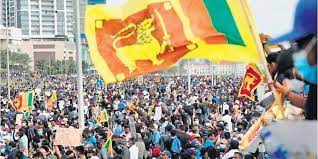President Gotabaya Rajapaksa appears to have been finally ousted by Sri Lanka’s economic crisis.
Before he was scheduled to leave office, Rajapaksa left the country early on Wednesday and is most likely travelling to the Maldives.
Following violent protests on Saturday in which protesters stormed the president’s official residence and set fire to the prime minister’s home in Colombo, the country’s parliamentary speaker announced Rajapaksa would resign. View More

In response to power outages, shortages of necessities, and rising prices, anti-government protesters have long called for Rajapaksa to resign. However, the retired military officer had resisted the calls for months, using emergency powers in an effort to maintain control.
The 22 million-person island nation is experiencing political unrest and violence as negotiations with the International Monetary Fund (IMF) over a rescue plan are ongoing. There are also plans to restructure its sovereign debt, which could further complicate matters.
How did this happen?
According to analysts, economic mismanagement by previous governments has weakened Sri Lanka’s public finances, leaving the country with national expenditures that are higher than its income and insufficient levels of production of tradable goods and services.
Deep tax cuts implemented by the Rajapaksa administration soon after taking office in 2019 made the situation worse. A few months later, COVID-19 broke out.
A significant portion of Sri Lanka’s revenue base was destroyed as a result, most notably from the lucrative tourism sector. Remittances from citizens who were working abroad also decreased as a result of a rigid foreign exchange rate.
From 2020 onward, rating agencies downgraded Sri Lanka’s credit ratings due to concerns about the government’s finances and its inability to repay significant foreign debt, ultimately locking the country out of international financial markets.
The government heavily relied on its foreign exchange reserves to maintain the economy, depleting them by more than 70% in just two years.
Sri Lanka, once regarded as a model for a developing economy, has been crippled by the crisis. Long lines at gas stations, frequent blackouts, and a shortage of medicine in hospitals have all been caused by fuel shortages. The central bank has warned that runaway inflation could reach 70%. It reached 54.6 percent last month.
What action took the government?
Despite the economy’s rapid decline, the Rajapaksa administration initially postponed discussions with the IMF.
The government was urged to take action for months by opposition leaders and some financial experts, but it resisted in the hopes that tourism and remittances would improve.
At some point, realising the severity of the impending crisis, the government did turn to nations like China and India, two regional superpowers that have long fought for control of the strategically important island.
India has made loans totaling billions of dollars available to help with the cost of essential supplies. New Delhi claims that it has offered assistance totaling more than $3.5 billion this year.
China hasn’t publicly intervened as much, but it has stated that it supports initiatives to help the island nation restructure its debt.
Rajapaksa asked China earlier in 2022 to restructure repayments on about $3.5 billion of debt that Beijing was owed, and Beijing also gave Sri Lanka a $1.5 billion yuan-denominated swap in late 2021.
The IMF and Sri Lanka eventually started speaking.



